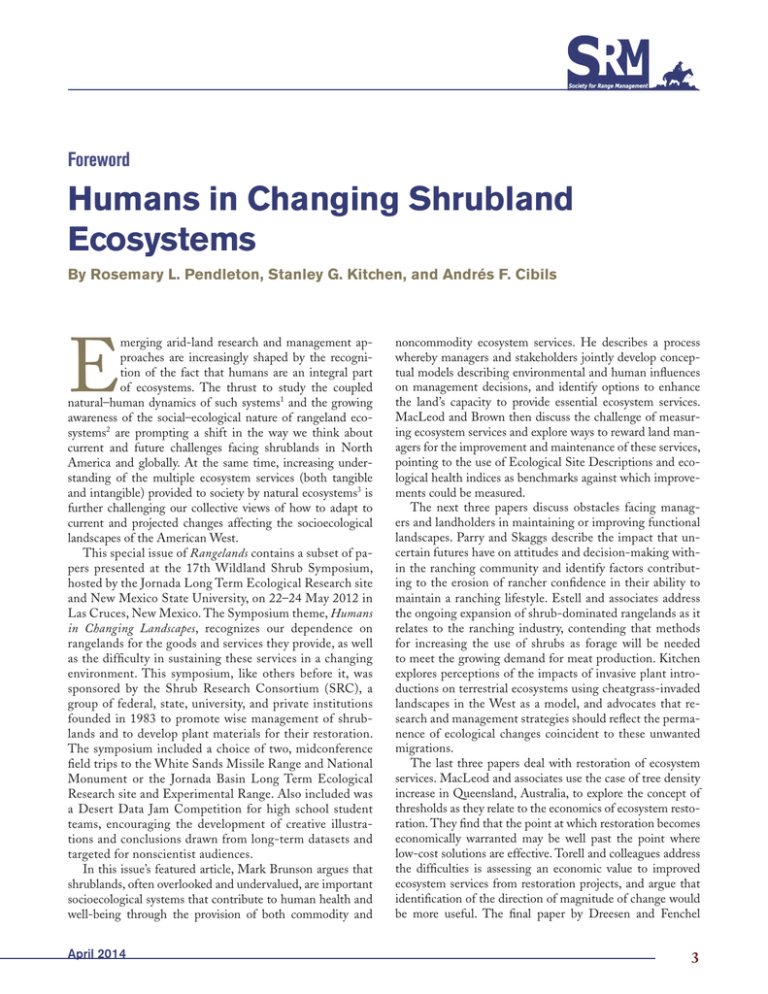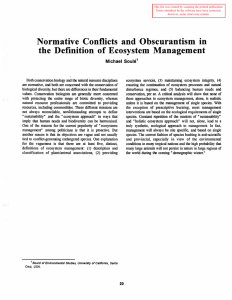E
advertisement

Foreword Humans in Changing Shrubland Ecosystems By Rosemary L. Pendleton, Stanley G. Kitchen, and Andrés F. Cibils E merging arid-land research and management approaches are increasingly shaped by the recognition of the fact that humans are an integral part of ecosystems. The thrust to study the coupled natural–human dynamics of such systems1 and the growing awareness of the social–ecological nature of rangeland ecosystems2 are prompting a shift in the way we think about current and future challenges facing shrublands in North America and globally. At the same time, increasing understanding of the multiple ecosystem services (both tangible and intangible) provided to society by natural ecosystems3 is further challenging our collective views of how to adapt to current and projected changes affecting the socioecological landscapes of the American West. This special issue of Rangelands contains a subset of papers presented at the 17th Wildland Shrub Symposium, hosted by the Jornada Long Term Ecological Research site and New Mexico State University, on 22–24 May 2012 in Las Cruces, New Mexico. The Symposium theme, Humans in Changing Landscapes, recognizes our dependence on rangelands for the goods and services they provide, as well as the difficulty in sustaining these services in a changing environment. This symposium, like others before it, was sponsored by the Shrub Research Consortium (SRC), a group of federal, state, university, and private institutions founded in 1983 to promote wise management of shrublands and to develop plant materials for their restoration. The symposium included a choice of two, midconference field trips to the White Sands Missile Range and National Monument or the Jornada Basin Long Term Ecological Research site and Experimental Range. Also included was a Desert Data Jam Competition for high school student teams, encouraging the development of creative illustrations and conclusions drawn from long-term datasets and targeted for nonscientist audiences. In this issue’s featured article, Mark Brunson argues that shrublands, often overlooked and undervalued, are important socioecological systems that contribute to human health and well-being through the provision of both commodity and April 2014 noncommodity ecosystem services. He describes a process whereby managers and stakeholders jointly develop conceptual models describing environmental and human influences on management decisions, and identify options to enhance the land’s capacity to provide essential ecosystem services. MacLeod and Brown then discuss the challenge of measuring ecosystem services and explore ways to reward land managers for the improvement and maintenance of these services, pointing to the use of Ecological Site Descriptions and ecological health indices as benchmarks against which improvements could be measured. The next three papers discuss obstacles facing managers and landholders in maintaining or improving functional landscapes. Parry and Skaggs describe the impact that uncertain futures have on attitudes and decision-making within the ranching community and identify factors contributing to the erosion of rancher confidence in their ability to maintain a ranching lifestyle. Estell and associates address the ongoing expansion of shrub-dominated rangelands as it relates to the ranching industry, contending that methods for increasing the use of shrubs as forage will be needed to meet the growing demand for meat production. Kitchen explores perceptions of the impacts of invasive plant introductions on terrestrial ecosystems using cheatgrass-invaded landscapes in the West as a model, and advocates that research and management strategies should reflect the permanence of ecological changes coincident to these unwanted migrations. The last three papers deal with restoration of ecosystem services. MacLeod and associates use the case of tree density increase in Queensland, Australia, to explore the concept of thresholds as they relate to the economics of ecosystem restoration. They find that the point at which restoration becomes economically warranted may be well past the point where low-cost solutions are effective. Torell and colleagues address the difficulties is assessing an economic value to improved ecosystem services from restoration projects, and argue that identification of the direction of magnitude of change would be more useful. The final paper by Dreesen and Fenchel 3 describes a cost-effective technique for restoring ecosystem function to degraded riparian zones through the deep planting of long-stem nursery stock to take advantage of water at the capillary fringe. This technique has proved effective in reducing the need for irrigation and improving transplant success. A list of the titles of all papers presented at the 17th Wildland Shrub Symposium and a link to the complete set of symposium abstracts is provided at the end of this special issue. References 1. National Science Foundation. 2013. Dynamics of coupled natural and human systems program. Available at: https://www. nsf.gov/funding/pgm_summ.jsp?pims_id=13681. Accessed 31 October 2013. 2. Bestelmeyer, B.T., and D. D. Briske. 2012. Grand challenges for resilience-based management of rangelands. Rangeland Ecology & Management 65:654–663. 4 3. Millennium Ecosystem Assessment. 2005. Ecosystems and human well-being: biodiversity synthesis. Washington, DC, USA: World Resources Institute. Authors are Research Ecologist, Rocky Mountain Research Station, USDA Forest Service, Albuquerque, NM 87102, USA (Pendleton); Research Botanist, Rocky Mountain Research Station, USDA Forest Service, Provo, UT 84606, USA (Kitchen); and Associate Professor of Range Science, New Mexico State University, Las Cruces, NM 88003, USA, acibils@nmsu.edu (Cibils). R. Pendleton and A. Cibils were co-organizers of the 17th Wildland Shrub Symposium. S. Kitchen is the chair of the Shrub Research Consortium. Rangelands 36(2):3–4 doi: 10.2111/RANGELANDS-D-14-00006.1 © 2014 The Society for Range Management Rangelands






